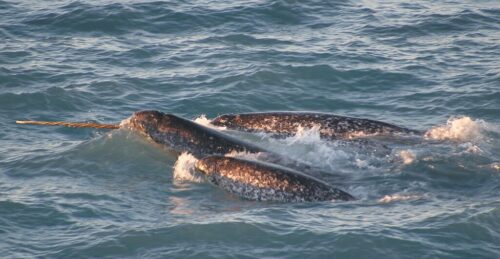Narwhals have fascinated humans for centuries: they inspired unicorn legends and to this day they’re known as the “unicorns of the sea.” Their tusks, enlarged teeth mostly present on males, can grow to about ten feet long and are by far their most famous attribute. Despite years of speculation about how narwhals use their tusks, evidence is lacking because these whales are difficult to study, and observations are scarce. Males may use their tusks to fight, hunt fish, and display to females, but we only have a few scattered reports of these behaviors. A recent study details two incidents that shed light on how these mysterious animals use their tusks to explore their environment, hunt, and play.
The study, published earlier this year in Frontiers in Marine Science, was conducted by a team of researchers including Cortney Watt, a scientist with Fisheries and Oceans Canada. They spent three weeks in Creswell Bay in Canada monitoring narwhals with drones. The paper describes two different observations of narwhals using their tusks to interact with Arctic char, a cold-water fish related to salmon.
In the first observation, three male narwhals were seen following one char. One of the whales followed the fish closely, keeping it just off the tip of his tusk. A younger narwhal in the group seemed hesitant to touch the fish, while the third, another adult male, was bolder. The two older whales were confident about approaching the fish, even bumping it gently a few times, but they weren’t trying to eat it. Instead, they seemed to be exploring and maybe even playing with the fish.
“This was the first documentation of more play-like behavior, and maybe even teaching and learning,” Watt said. The younger male may have been learning about the fish from watching his older companions, a behavior that hadn’t been documented before in narwhals. For many social animals, play teaches life skills and strengthens social bonds, but we don’t know enough about narwhal society to say for sure what role this behavior plays for them.
In the second observation, the researchers described a larger group of narwhals hitting Arctic char with their tusks hard enough to stun them. “Although we had seen them stunning prey before, it wasn’t really thought that Arctic char were a major part of their diet, so that was exciting for me,” Watt said. This is evidence that narwhals may have more food sources than scientists previously thought, since Arctic char are abundant in their habitat.
This study provides key insights into how narwhals interact with their environment, but there’s still a lot we don’t know. Drones can give us a glimpse into how narwhals may interact with each other when humans aren’t around to disturb them. “Play has to only happen in times when they have time and are not focused on heavily foraging and not stressed, and so I think that suggests that this method of observing them is not stressful,” Watt said. With advancing technologies, she hopes to gain a better understanding of narwhal ecology to help predict how they’ll be impacted by climate change—or how they may have already been impacted. “To be able to measure change you need to have baseline monitoring and an understanding of their physiology or their behavior,” Watt said. This study is a first step towards that critical understanding.

